A campaign to promote carbon capture in California by the Lawrence Livermore National Lab received $1 million from a front group run by executives of DTE Energy, a Michigan-based utility whose subsidiary owns biomass power plants in California that could benefit from policies promoting carbon capture.
Emails obtained through public records requests show that the Chief Advisor to former California Air Resources Board Chair Mary Nichols advised the Livermore Lab’s carbon capture campaign on how to influence his own agency – before leaving to lobby for oil, gas, and power companies as the executive director of the “California Carbon Capture Coalition.”
The involvement of power plant operators and oil companies in the campaign to promote carbon capture as a key part of California’s climate plans underscores concerns among environmental justice advocates and climate policy experts about the scope and focus of carbon capture and carbon removal efforts in a plan under development by the California Air Resources Board. And the funding arrangement raises questions about the Department of Energy’s oversight of its National Lab’s industry partnerships.
DTE Energy front group paid $1 million to Livermore Lab Foundation for carbon capture campaign
A front group run by executives of DTE Energy, the Michigan-based utility company whose subsidiary owns biomass power plants in California, spent $1 million on a campaign to influence communities and high school students in California’s San Joaquin Valley, by promoting a Livermore Lab report that encourages carbon capture for biomass power plants.
Livermore Lab Foundation’s 2020 tax filing includes a note explaining:
Funding from the Clean and Sustainable Energy (CASE) Fund allowed the Foundation to survey more than 1,200 residents in the San Joaquin Delta region and Kern County on their views on climate change, carbon neutrality and carbon capture and storage. Both of these areas represent some of the most suitable locations for long-term geological storage of CO2. The results are shaping an outreach toolkit to provide stakeholders, community leaders and educators with the science behind carbon neutrality as well as societal benefits.
The “Clean and Sustainable Energy Fund” 2020 tax filing shows that it is a 501(c)(4) group run by executives of DTE Energy, including Renze Hoeksema, DTE Energy Vice President of Corporate and Government Affairs, Theresa Uzenski, manager of regulatory accounting at DTE Energy, and Skilles Boyd, Vice President Environmental at DTE Energy. That tax filing also reports that the “Clean and Sustainable Energy Fund” provided $700,000 to the Livermore Lab Foundation in 2020, and $100,000 to Energy Futures Initiative, an organization led by former Energy Secretary Ernest Moniz.
The tax filing also shows that all of the money that the “Clean and Sustainable Energy Fund” received in 2020, $3 million, came from “Michigan Energy First,” another 501(c)(4) group run by the same DTE Energy executives, which has historically worked unabashedly on behalf of DTE Energy’s political agenda.
The Los Angeles Times first reported on the tax filings showing the financial connections between the Livermore Lab’s carbon capture campaign and the front groups run by DTE Energy executives.
DTE Vantage, a subsidiary of DTE Energy, owns biomass power plants in California’s San Joaquin Valley, including at the Port of Stockton, Woodland, and Bakersfield.
In response to a question from EPI, Livermore Lab Foundation Executive Director Sally Allen said that the Foundation had received another $300,000 from the “Clean and Sustainable Energy Fund” in 2021, in addition to the $700,000 in 2020. Allen also said that donors don’t control the use of funds they provide to the Foundation:
In 2020, LLF received a $700K gift from the CASE Fund, designated for science outreach and education related to carbon management solutions. Consistent with LLF’s 501(c)(3) status, these funds may only be used for scientific, educational, and charitable purposes. No donor controls the use of funds contributed to LLF, nor are donated funds used to provide any direct benefit to the donor.
Allen did not say whether the Livermore Lab Foundation has made any decisions about continuing to receive funding from the “Clean and Sustainable Energy Fund.”
A spokesperson for Livermore Lab said “It’s important to note that Lawrence Livermore National Laboratory (LLNL) and the Livermore Lab Foundation (LLF) are separate entities,” and pointed to the Lab’s Strategic Partnership Projects Program:
Through the Strategic Partnership Projects Program, LLNL makes its resources and skills available to address the specific needs of federal agencies other than DOE, state and local governments and, occasionally, commercial companies and others. All proposed SPP projects are vetted by the Laboratory and the DOE to ensure they are consistent with or enhance the Laboratory’s mission, and LLNL researchers are bound by strict standards of scientific conduct. No non-DOE funding source influences our work, conclusions or public messaging and posture.
A Department of Energy “Guide to Partnering with DOE’s National Laboratories” provides details about a variety of ways that companies and organizations can work with National Labs using official channels, such as Cooperative Research and Development Agreements (CRADA), Strategic Partnership Projects (SPP), Agreements for Commercializing Technology (ACT), and more, each with their own rules and policies. The DOE guide does not mention passing money through 501(c)(4) groups to a National Lab Foundation as a way to partner with a National Lab.
Despite multiple requests, the Department of Energy press office did not respond to EPI’s question: “Does this funding arrangement comply with Department of Energy policies governing partnerships between the National Labs and industry?”
Should carbon capture play a focused or broad role in California climate policy?
One example of the debate over the scale and appropriate role of carbon capture in California’s climate plans came up during the debate over SB 905, a bill that would create a carbon capture demonstration program for cement production. During a March 28 hearing at the California Senate Environmental Quality Committee, ClimateWorks Foundation Industry Program Director Rebecca Dell explained why the bill would focus on the cement industry:
“Cement is the sector with the clearest case for relying on carbon capture and storage to reduce emissions. So if we want to start to explore CCS as a pathway to climate action, cement is the correct, no-regrets place to start.”
But that focus on cement drew the opposition of Virgil Welch, the executive director of the California Carbon Capture Coalition, whose members include Chevron, SoCalGas, Western States Petroleum Association, Calpine, and Aera, a joint venture between Exxon and Shell.
“Our concern with this bill is that the focus on cement could very well have the impact of impeding other critical CCUS deployment in other sectors, the power sector, the oil and gas sector,” said Welch.
Immediately after Welch spoke, a lobbyist with the Western States Petroleum Association echoed his comments, stating only that the oil industry group’s position was to: “oppose unless amended, as previously stated.”
Carbon capture lobbyist coordinated with Livermore Lab staff while advising CARB Chair
Beyond his role as the executive director of the California Carbon Capture Coalition, Welch is also a lobbyist with Caliber Strategies. Although the lobbying firm’s website doesn’t list the California Carbon Capture Coalition among its clients, lobbying activity reports show that beginning in the third quarter of 2021, the group paid Caliber Strategies for lobbying at the California legislature, Governor’s office, Natural Resources Agency, and California Air Resources Board (CARB).
A lobbying activity report for the second quarter of 2021 shows that Caliber Strategies also lobbied CARB on behalf of POET LLC, the world’s largest ethanol producer, which signed a deal last month with Navigator for its carbon capture pipeline project for ethanol facilities in the Midwest. CARB administers California’s Low Carbon Fuel Standard, which provides subsidies that are driving interest in carbon capture projects at ethanol facilities.
The California Air Resources Board is well-known to Welch – until March 2021, he was Chief Advisor and Special Counsel to California Air Resources Board (CARB) Chair Mary Nichols.
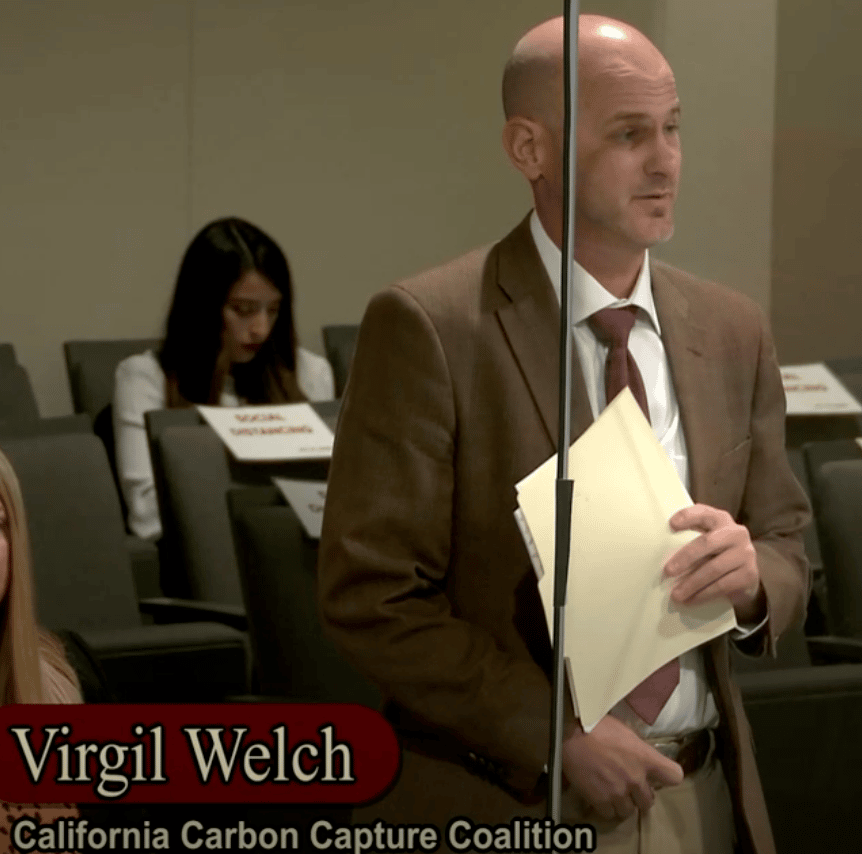
Emails obtained through the California Public Records Act show that while he was working at CARB, Welch advised Livermore Lab staff on a campaign to influence his own agency to focus on carbon capture as it developed its next five-year plan to reduce emissions in California. The emails were obtained by Biofuelwatch and some were published in a December 2021 report, “Carbon Capture or Captured Futures? Fossil Fuel and Bioenergy Controls California “Getting to Neutral” Climate Policy,” while others were shared with EPI by Biofuelwatch.
Some emails show Livermore Lab Energy Program Chief Scientist Roger Aines and Livermore Lab Carbon Management Partnership Director George Peridas seeking advice from Welch about op-ed strategies to promote the Livermore Lab report, before it was published.
Welch responded that the Livermore Lab report “Will be most useful”
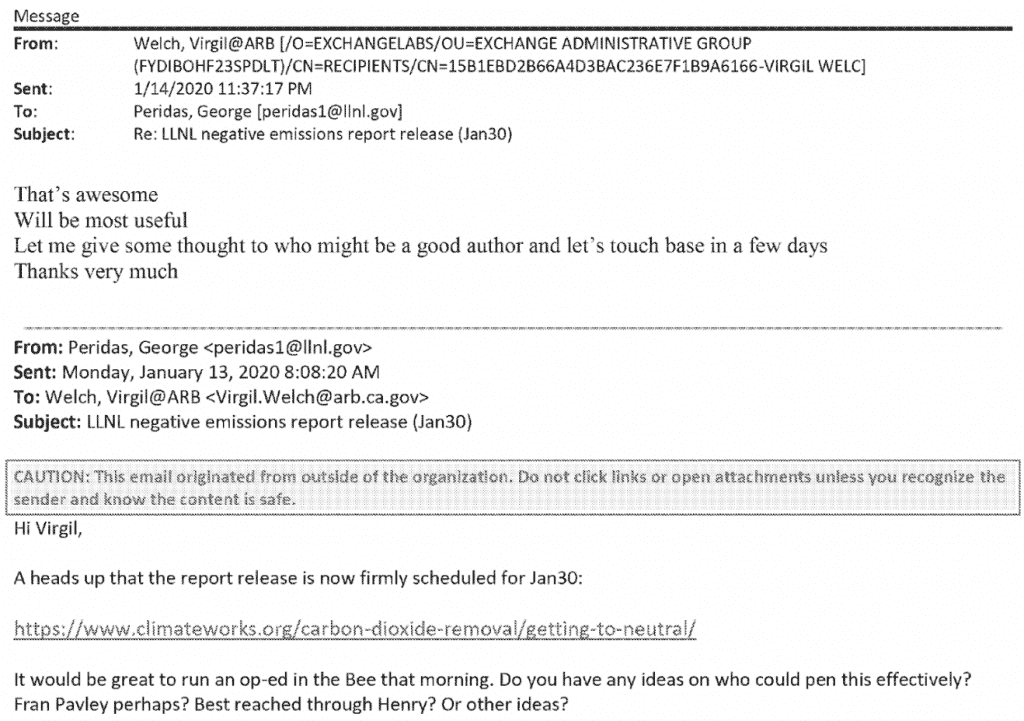
Now as a lobbyist for oil, gas and power companies that could benefit from policies that promote carbon capture in California, Welch regularly uses the Livermore Lab report.
On March 24, Welch testified to his former agency on behalf of the California Carbon Capture Coalition, during a meeting to inform the development of the CARB scoping plan. Welch explained that his fossil fuel industry lobbying group works “to create a comprehensive policy framework to ensure that carbon capture utilization and sequestration technologies can play a key role in achievement of California’s climate goals,” and noted that “analyses from places like Lawrence Livermore and Stanford all demonstrate the key role that CCS has to play in these efforts.”
A report commissioned by the California Carbon Capture Coalition cites the Livermore Lab report, as does a flier from the group.
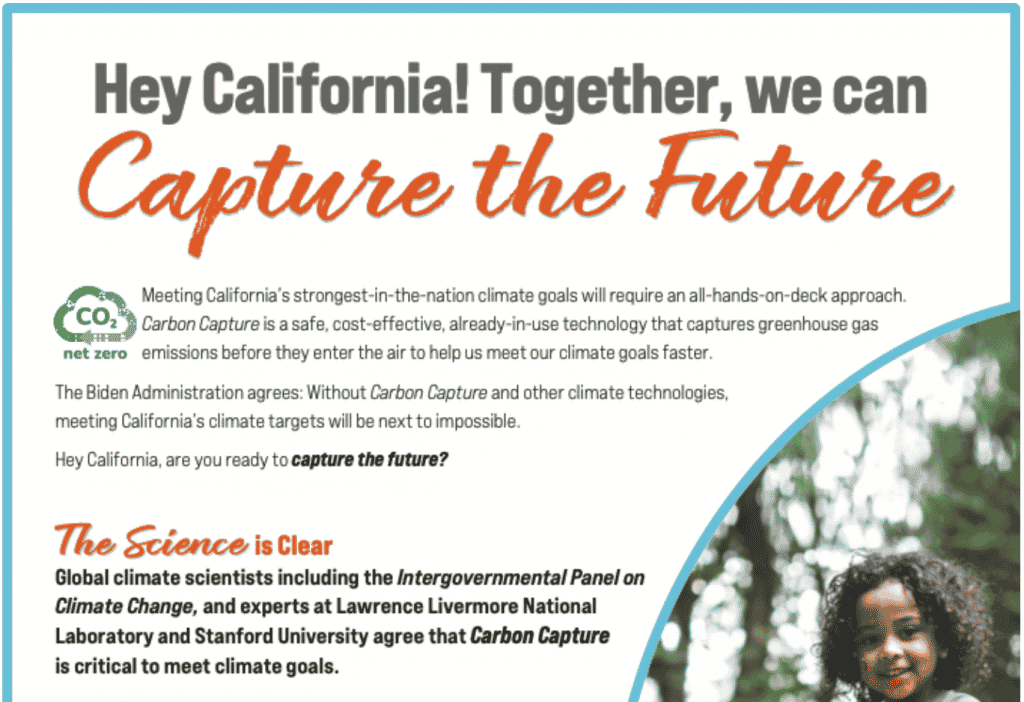
CARB draft scoping plan embraces major role for carbon dioxide removal, and carbon capture at oil refineries
The efforts of Livermore Lab staff, lobbyists like Welch, and others to promote carbon capture and carbon dioxide removal as central to California’s climate plans appears to have been successful, at least so far.
The CARB draft scoping plan published in May “assumes CCS for petroleum refineries” and also imagines a major role for carbon dioxide removal relative to emissions reductions; much more than states like Washington and New York, as Danny Cullenward of Carbon Plan explained in a critique of the plan.
That has prompted criticism from climate policy experts and environmental justice groups in California. In an op-ed for the Los Angeles Times, UC Berkeley Professor Dan Kammen wrote:
As a next step, regulators need to acknowledge it is far too late in the game to gamble our state’s future on unproven carbon capture technologies that may never materialize. CARB’s draft scoping plan projects that California will use 100 million metric tons (MMT) of direct air capture in 2045. Globally, only 0.01 MMT of annual direct air capture is happening today. It is unrealistic to assume we can scale up this technology so much overnight, and foolish to direct investment to unproven experiments when affordable natural carbon removal solutions like composting and tree-planting are readily available now.
The CARB scoping plan also drew criticism from environmental justice groups in California, who wrote to CARB Chair Liane Randolph last month to outline their priorities for the scoping plan, including that “CCS should have no role for enhanced oil recovery, refineries, or power plants, and more promising mitigation should be prioritized for industrial decarbonization.”
Most carbon capture proposals in California are located in communities in the San Joaquin Valley already impacted by higher levels of pollution.
*New*: we made an interactive map of proposed carbon capture & storage (CCS) projects in CA: https://t.co/ylSCBufB53
— Victoria Bogdan Tejeda (@v_bogg) July 20, 2022
We added a CalEnviroScreen to show how most all projects would be located in areas already overburdened by pollution & hazards.
by @CenterForBioDiv pic.twitter.com/wjGi9sKGJK
“Because there’s nothing in the plan that talks about shutting down refining capacity or sunsetting these operations, the concern I’m hearing from people — and I think this is a legitimate concern — is that this could start us down the path of major CCS projects that lock in fossil fuel infrastructure rather than transition it responsibly to a different direction,” Cullenward told the Los Angeles Times.
At a public hearing last month that CARB hosted to receive public feedback to the draft scoping plan, hundreds of environmental justice advocates showed up to speak, and at one point interrupted the meeting in protest.
During the protest, Welch, who was sitting a few feet away, laughed.
I’d like to point out that the “industry people just laughing at this” at 0:16 — that’s Virgil Welch, the former advisor to ex-CARB Chair Mary Nichols; he’s now running an industry lobbying shop for CCUS. https://t.co/xmU6BwElZI https://t.co/02KLOnnSvK
— Danny Cullenward (@dcullenward) June 23, 2022
Livermore Lab staff claim they have “No dog in the climate fight”
In another email obtained through the California Public Record Act, Livermore Lab’s Aines asked Welch about a potential op-ed author, Ryan McCarthy. Like Welch, McCarthy was also an advisor to CARB Chair Mary Nichols before becoming a lobbyist, at Weideman Group in May 2019.
Welch responded “I love Ryan and all but I don’t think a lobbyist is really a very useful voice.”
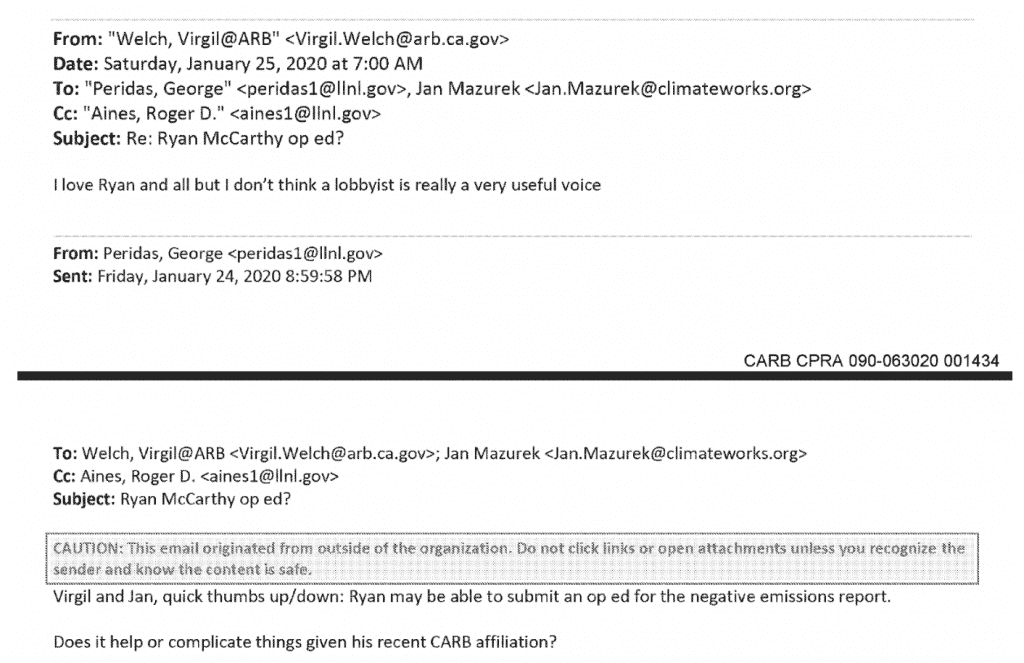
During the March 24 CARB hearing, Livermore Lab’s George Peridas prefaced his remarks about carbon capture by stating: “Our job is to solve hard problems and represent science. We do not stand to profit from any climate solution and we don’t have any dog in the fight, except helping to solve climate change.” (page 255)
A couple months later, Peridas used almost the exact same phrase to begin his remarks at a May 31 hearing before the California Joint Legislative Committee on Climate Change Policies: “At Livermore we have no dog in the climate fight, our job is to solve hard problems.” (minute 35:18)
At that hearing, California State Senator Bob Wieckowski pointed to the influence of the Livermore Lab report: “It seems as though our – as legislators, our attention has been piqued by the Livermore report and other subjects, saying – it’s not an option for the state of California on whether to use carbon capture or not.” (minute 32:09)
Senator Wieckowski is chair of the Senate’s Budget and Fiscal Review subcommittee on Resources, Environmental Protection and Energy, and the lead sponsor of SB 1399, which would “provide grants to eligible entities, as defined, for 3 projects that each capture or utilize carbon dioxide from an existing industrial facility, natural gas electric generation facility, or biomass electric generation facility.” SB1399 passed the California Senate on May 25.
In the year after publishing their “Getting to Neutral” report, Livermore Lab staff had briefed California legislators 12 times, according to the Lab’s website:
Authors have briefed state agencies and officials 19 times, and state legislators and staff 12 times. The LLNL team is coordinating closely with the California Air Resources Board (CARB) as they formulate their plan for net carbon neutrality by 2045.
“National Labs are seen as highly credible messengers in the Delta”
Representatives of Livermore Lab and Livermore Lab Foundation have also emphasized their independence in presentations to community groups – even when presenting the results of polling funded by the front group run by DTE Energy executives.
In an October 21, 2021 forum hosted by Restore the Delta, which describes itself as “a grassroots campaign of residents and organizations committed to restoring the Sacramento-San Joaquin Delta,” Susan Halton with the Livermore Lab Foundation discussed the results of a poll titled “Community views of carbon capture and geologic storage projects.”
Halton concluded her remarks: “Who are the trusted messengers? I think Matt discussed some of the concerns, and we certainly saw in the chat and that Barbara said. You want the trusted sources, you want people like you guys here today being comfortable with this, because it can’t be developers coming in and talking to you about what might happen. So the results of this, from a Lab perspective – and just quickly, the Lab doesn’t do policy, the Lab doesn’t advocate, nor does our Foundation. Our job is to understand how people understand science, and how we can make it better.” (minute 1:11:42)
Halton’s concluding slide notes that “The most trusted messengers are those perceived as neutral experts without an ideological or economic stake: farming and ranching families, doctors and nurses, firefights. National Labs are seen as highly credible messengers in the Delta.”
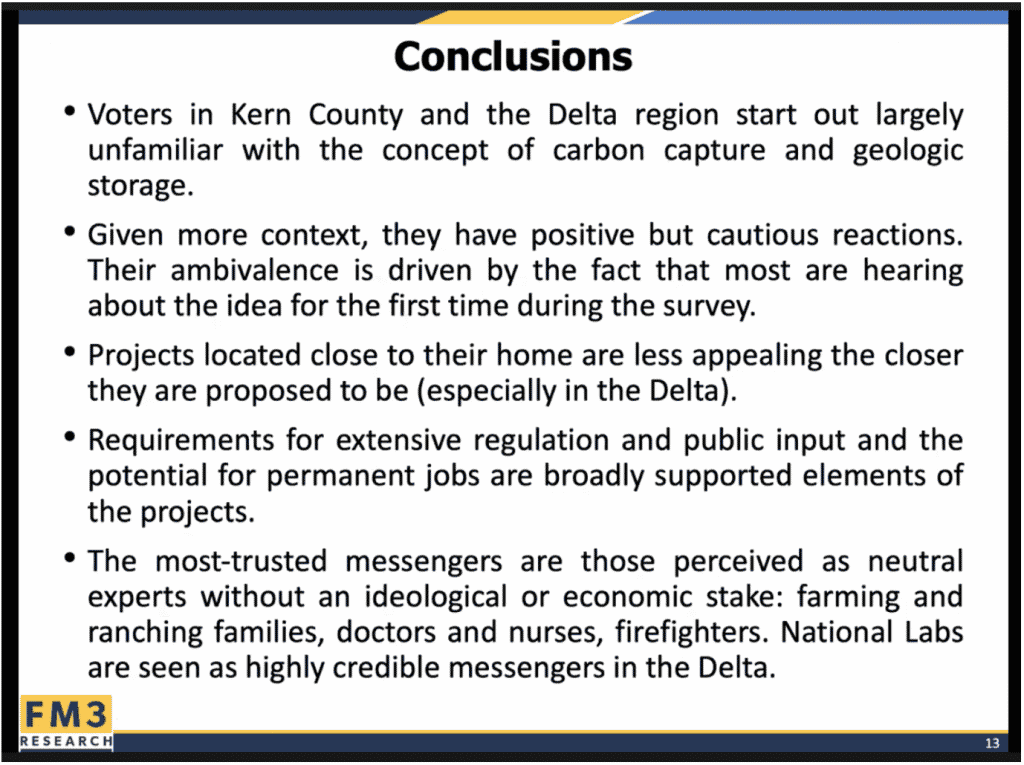
After the Los Angeles Times reported on the funding source for the Livermore Lab carbon capture campaign, Restore the Delta tweeted that the dark money group is “not welcome in the Delta”
A dark money group we do not welcome in the Delta. https://t.co/2thmc7sgza
— Restore the Delta (@RestoretheDelta) June 24, 2022
During another Livermore Lab presentation, Delta Protection Commission Executive Director Erik Vink explained that communities may be skeptical of carbon capture proposals because of the history of infrastructure projects in the Delta.
“The Delta Community, and especially the vast rural area of the Delta, has great sensitivity to large infrastructure projects that are really primarily designed to serve others with little or no local benefit to the Delta… We’re a region that is very sensitive to anyone coming from outside the region, saying we’ve got a great idea here that’s primarily to serve others, but it’s going to be good for you as well.” (minute 1:18:27)
In an email response to EPI, Erik Vink said he didn’t recall if Livermore Lab staff had disclosed its funding sources during that forum, “but it is interesting to note.”
Livermore Lab “educational toolkit” focuses on carbon capture
In addition to pushing carbon capture to legislators, regulators, and community groups, Livermore Lab Foundation used some of the money from the front group run by DTE Energy executives to launch an “educational toolkit” for high school students and teachers in the San Joaquin Valley.
A slide deck for the education toolkit – which is titled “CCS Storyboard” – shows that the toolkit includes four activities, and the longest one is focused on “Modeling Carbon Capture Storage in the Delta or Kern Region to Meet California’s Emission Goals.”
The materials outline that students are expected to spend six hours learning about carbon capture, after two hours spent learning about “global implications of excess CO2” and four hours learning about “Acidification of the Oceans.” Students then spend two hours making a “Carbon Neutrality, Capture and Storage Public Service Announcement.”
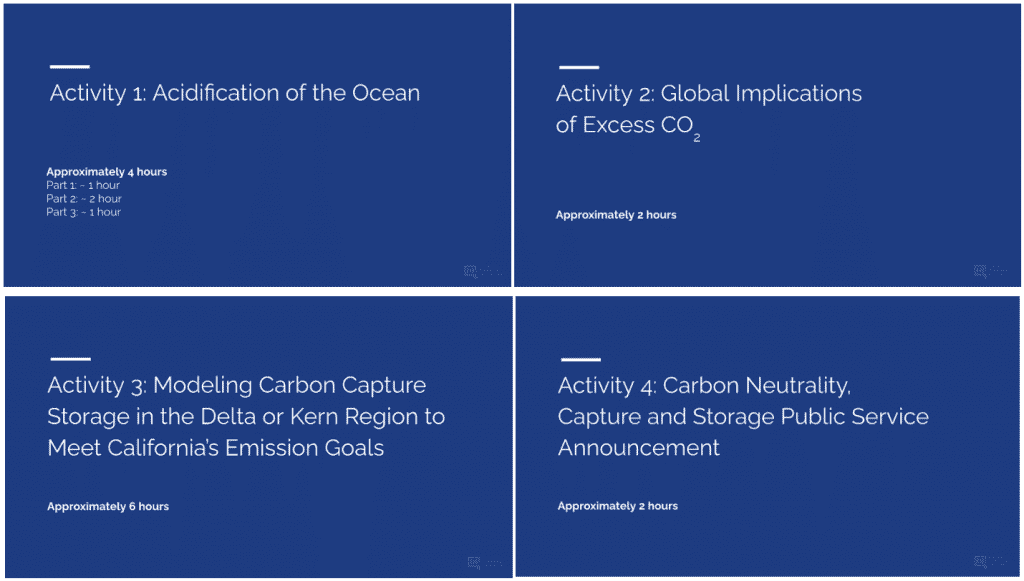
A list of teachers using the Livermore Lab “education toolkit” shows that all are in the San Joaquin Valley, including in communities located near DTE Energy’s biomass power plants.
The “CCS Storyboard” education toolkit also appears to support one of DTE Energy’s stated goals. In a presentation titled “Introduction to DTE Energy’s California Carbon Storage Initiative,” the company noted: “Stakeholder education on the safety and role of CCS in combating climate change is imperative.”
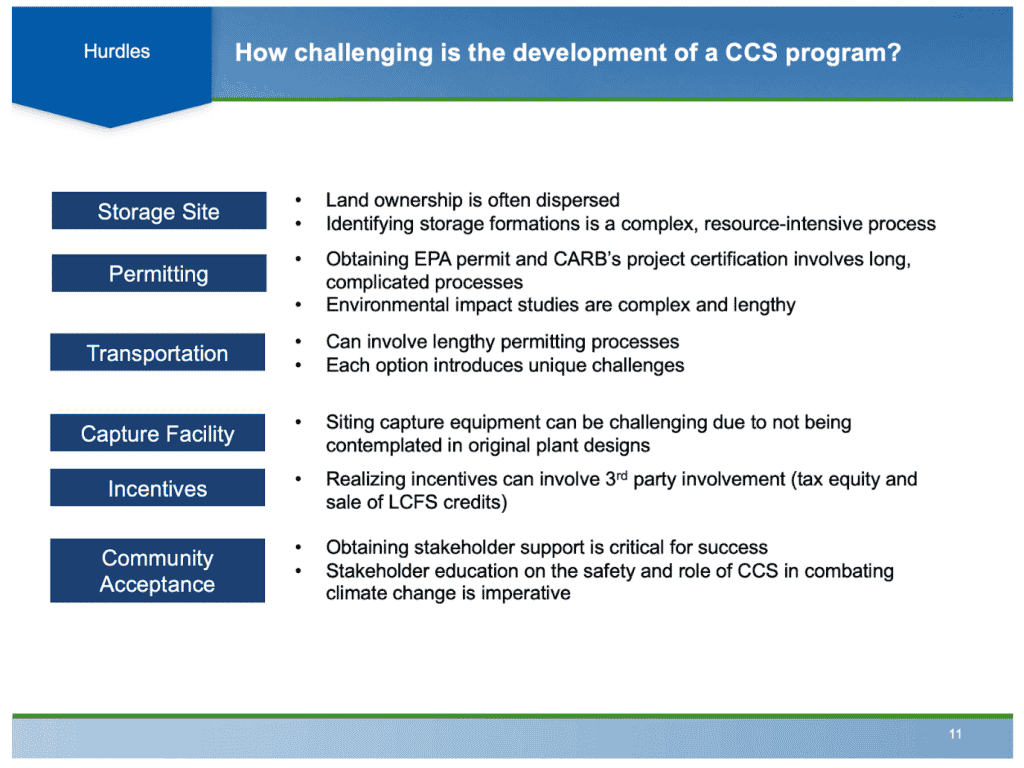


[…] Read More: Livermore Lab carbon capture campaign funded by utility company front group […]
[…] Read More:Livermore Lab carbon capture campaign funded by utility company front group […]
[…] Supply hyperlink […]
[…] (Source:Energy and Policy Institute) A campaign to promote carbon capture in California by the Lawrence Livermore National Lab received $1 million from a front group run by executives of DTE Energy, a Michigan-based utility whose subsidiary owns biomass power plants in California that could benefit from policies promoting carbon capture. The involvement of power plant operators and oil companies in the campaign to promote carbon capture as a key part of California’s climate plans underscores concerns among environmental justice advocates and climate policy experts about the scope and focus of carbon capture and carbon removal efforts in a plan under development by the California Air Resources Board.……Read full article […]
[…] friendliness to the growing carbon capture sector is linked to the growing lobby for biofuels, reporting from the Energy and Policy Institute’s Joe Smyth has shown. A national lab overseen by the […]
[…] on distributed renewable energy development, and electric cooperatives. His recent article “Livermore Lab carbon capture campaign funded by utility company front group” is the focus of this episode of Terra […]
[…] boost a Lawrence Livermore National Laboratory campaign to promote CCS in California, according to emails published by the Energy and Policy Institute, a watchdog […]
[…] boost a Lawrence Livermore National Laboratory campaign to promote CCS in California, according to emails published by the Energy and Policy Institute, a watchdog […]
[…] boost a Lawrence Livermore National Laboratory campaign to promote CCS in California, according to emails published by the Energy and Policy Institute, a watchdog […]
[…] boost a Lawrence Livermore National Laboratory campaign to promote CCS in California, according to emails published by the Energy and Policy Institute, a watchdog […]
[…] boost a Lawrence Livermore National Laboratory campaign to promote CCS in California, according to emails published by the Energy and Policy Institute, a watchdog […]
[…] boost a Lawrence Livermore National Laboratory campaign to promote CCS in California, according to emails published by the Energy and Policy Institute, a watchdog […]
[…] boost a Lawrence Livermore National Laboratory campaign to promote CCS in California, according to emails published by the Energy and Policy Institute, a watchdog […]
[…] boost a Lawrence Livermore National Laboratory campaign to promote CCS in California, according to emails published by the Energy and Policy Institute, a watchdog […]
[…] boost a Lawrence Livermore National Laboratory campaign to promote CCS in California, according to emails published by the Energy and Policy Institute, a watchdog […]
[…] boost a Lawrence Livermore National Laboratory campaign to promote CCS in California, according to emails published by the Energy and Policy Institute, a watchdog […]
[…] boost a Lawrence Livermore National Laboratory campaign to promote CCS in California, according to emails published by the Energy and Policy Institute, a watchdog […]
[…] boost a Lawrence Livermore National Laboratory campaign to promote CCS in California, according to emails published by the Energy and Policy Institute, a watchdog […]
[…] boost a Lawrence Livermore National Laboratory campaign to promote CCS in California, according to emails published by the Energy and Policy Institute, a watchdog […]
[…] boost a Lawrence Livermore National Laboratory campaign to promote CCS in California, according to emails published by the Energy and Policy Institute, a watchdog […]
[…] boost a Lawrence Livermore National Laboratory campaign to promote CCS in California, according to emails published by the Energy and Policy Institute, a watchdog […]
[…] boost a Lawrence Livermore National Laboratory campaign to promote CCS in California, according to emails published by the Energy and Policy Institute, a watchdog […]
[…] boost a Lawrence Livermore National Laboratory campaign to promote CCS in California, according to emails published by the Energy and Policy Institute, a watchdog […]
[…] boost a Lawrence Livermore National Laboratory campaign to promote CCS in California, according to emails published by the Energy and Policy Institute, a watchdog […]
[…] boost a Lawrence Livermore National Laboratory campaign to promote CCS in California, according to emails published by the Energy and Policy Institute, a watchdog […]
[…] boost a Lawrence Livermore National Laboratory campaign to promote CCS in California, according to emails published by the Energy and Policy Institute, a watchdog […]
[…] boost a Lawrence Livermore National Laboratory campaign to promote CCS in California, according to emails published by the Energy and Policy Institute, a watchdog […]
[…] Nationwide Laboratory marketing campaign to advertise CCS in California, in accordance with emails published by the Vitality and Coverage Institute, a watchdog […]
[…] boost a Lawrence Livermore National Laboratory campaign to promote CCS in California, according to emails published by the Energy and Policy Institute, a watchdog […]
[…] boost a Lawrence Livermore National Laboratory campaign to promote CCS in California, according to emails published by the Energy and Policy Institute, a watchdog […]
[…] boost a Lawrence Livermore National Laboratory campaign to promote CCS in California, according to emails published by the Energy and Policy Institute, a watchdog […]
[…] boost a Lawrence Livermore National Laboratory campaign to promote CCS in California, according to emails published by the Energy and Policy Institute, a watchdog […]
[…] Livermore Nationwide Laboratory marketing campaign to advertise CCS in California, in response to emails printed by the Power and Coverage Institute, a watchdog […]
[…] boost a Lawrence Livermore National Laboratory campaign to promote CCS in California, according to emails published by the Energy and Policy Institute, a watchdog […]
[…] boost a Lawrence Livermore National Laboratory campaign to promote CCS in California, according to emails published by the Energy and Policy Institute, a watchdog […]
[…] boost a Lawrence Livermore National Laboratory campaign to promote CCS in California, according to emails published by the Energy and Policy Institute, a watchdog […]
[…] boost a Lawrence Livermore National Laboratory campaign to promote CCS in California, according to emails published by the Energy and Policy Institute, a watchdog […]
[…] boost a Lawrence Livermore National Laboratory campaign to promote CCS in California, according to emails published by the Energy and Policy Institute, a watchdog […]
[…] boost a Lawrence Livermore National Laboratory campaign to promote CCS in California, according to emails published by the Energy and Policy Institute, a watchdog […]
[…] boost a Lawrence Livermore National Laboratory campaign to promote CCS in California, according to emails published by the Energy and Policy Institute, a watchdog […]
[…] Livermore Nationwide Laboratory marketing campaign to advertise CCS in California, in line with emails published by the Power and Coverage Institute, a watchdog […]
[…] boost a Lawrence Livermore National Laboratory campaign to promote CCS in California, according to emails published by the Energy and Policy Institute, a watchdog […]
[…] Livermore National Laboratory marketing campaign to advertise CCS in California, in response to emails published by the Energy and Policy Institute, a watchdog […]
[…] plan also cites a study by Lawrence Livermore National Laboratory on point source capture that was promoted — through layers of front groups — by Michigan utility company DTE Energy, which has biomass […]
[…] cites a research by Lawrence Livermore Nationwide Laboratory on level supply seize that was promoted — by layers of entrance teams — by Michigan utility firm DTE Power, which has biomass energy […]
[…] cites a study by Lawrence Livermore Nationwide Laboratory on level supply seize that was promoted — by layers of entrance teams — by Michigan utility firm DTE Vitality, which has biomass […]
[…] plan also cites a study by Lawrence Livermore National Laboratory on point source capture that was promoted — through layers of front groups — by Michigan utility company DTE Energy, which has biomass […]
[…] plan also mentions a studyLawrence Livermore National Laboratory, point source capture promoted — through layers of front groups — by Michigan utility company DTE Energy, which has biomass […]
[…] also cites a study by Lawrence Livermore National Laboratory on point source capture that was promoted—through layers of front groups—by Michigan utility company DTE Energy, which has biomass power […]
[…] also cites a study by Lawrence Livermore National Laboratory on point source capture that was promoted — through layers of front groups — by Michigan utility company DTE Energy, which has biomass […]